Spices have been an integral part of human history for centuries, adding depth, flavor, and aroma to our culinary creations. From the exotic spices of the East to the fiery chilies of the Americas, the world of spices is a vast and tantalizing realm waiting to be explored. In this article, we invite you to
Spices have been an integral part of human history for centuries, adding depth, flavor, and aroma to our culinary creations. From the exotic spices of the East to the fiery chilies of the Americas, the world of spices is a vast and tantalizing realm waiting to be explored. In this article, we invite you to embark on a journey of bold and aromatic foods as we delve into the spice chronicles, uncovering the secrets behind these remarkable ingredients and the culinary traditions they represent.
The Spice Trade and Global Influence:
The story of spices is intertwined with the history of trade and exploration. The spice trade routes that spanned the globe connected distant lands and cultures, shaping economies and influencing culinary practices. From the ancient Silk Road to the Portuguese voyages of discovery, the quest for spices spurred exploration and played a significant role in shaping the world as we know it today. The allure of spices such as cinnamon, cardamom, and saffron captured the imaginations of explorers and traders, creating a demand that crossed borders and oceans.
Exotic Flavors of the East:
The East, particularly countries like India, China, and Thailand, is known for its vibrant and aromatic spices. Indian cuisine, with its rich array of spices like turmeric, cumin, and coriander, creates a symphony of flavors that tantalize the taste buds. The fragrant spices of Thai cuisine, including lemongrass, galangal, and kaffir lime leaves, transport us to the bustling markets of Bangkok. Chinese cuisine, with its delicate balance of flavors and use of spices like star anise and Sichuan peppercorns, offers a unique culinary experience.
Fiery Delights of the Americas:
In the Americas, spices like chili peppers have played a central role in indigenous cuisine for centuries. The Aztecs and Mayans cultivated a wide variety of chili peppers, using them as both a flavor enhancer and for their medicinal properties. Today, the culinary traditions of Mexico, the Caribbean, and South America are renowned for their spicy and bold flavors. From the smoky heat of chipotle peppers to the fiery kick of habaneros, these spices add depth and complexity to dishes such as mole, jerk chicken, and ceviche.
Mediterranean Magic:
The Mediterranean region is another treasure trove of aromatic spices and herbs. The combination of spices like oregano, thyme, and rosemary creates the distinct flavor profile found in dishes from Greece, Italy, and Morocco. The warm and earthy flavors of cumin, paprika, and turmeric are key ingredients in Middle Eastern cuisine, adding depth to dishes like falafel, hummus, and tagines. The Mediterranean diet, celebrated for its health benefits, owes much of its appeal to the rich flavors imparted by these spices.
Spices in Modern Cuisine:
In the modern culinary landscape, spices continue to inspire chefs and home cooks alike. The art of spice blending and seasoning allows for endless creativity in the kitchen. From traditional dishes passed down through generations to innovative fusion cuisine, spices play a crucial role in elevating flavors and creating memorable dining experiences. Chefs experiment with spice pairings and combinations, exploring the boundaries of taste and pushing culinary boundaries.
Health Benefits and Healing Properties:
Beyond their culinary appeal, many spices also offer a range of health benefits and healing properties. Turmeric, with its active compound curcumin, has been praised for its anti-inflammatory properties. Cinnamon has been linked to improved blood sugar control, while ginger is known for its soothing effects on digestion. These spices have been used in traditional medicine for centuries and are now gaining recognition in modern scientific research.
Cultural Significance and Rituals:
Spices hold deep cultural significance and often play a role in traditional rituals and celebrations. In many cultures, spices are used to mark important milestones, such as weddings and religious ceremonies. They are also valued for their symbolic meanings, such as prosperity, fertility, or protection against evil spirits. The act of grinding spices by hand or preparing a spice blend becomes a ritual, connecting us to our heritage and the stories of our ancestors.
Conclusion:
The spice chronicles take us on a journey of exploration, discovery, and sensory delight. They remind us of the rich tapestry of flavors and traditions that exist around the world. Whether we’re indulging in the exotic spices of the East, savoring the fiery flavors of the Americas, or embracing the aromatic magic of the Mediterranean, spices have the power to transport us to different times and places. They awaken our senses, ignite our palates, and create unforgettable culinary experiences.
So, let us embrace the spice chronicles and embark on a journey of bold and aromatic foods. Let us celebrate the diversity of flavors and the cultural richness that spices bring to our plates. Through the exploration of these extraordinary ingredients, we can deepen our understanding of different cuisines, foster cultural appreciation, and create a world where the joy of food knows no boundaries

















Leave a Comment
Your email address will not be published. Required fields are marked with *